React Hook 高级用法
一. Hook高级使用
1.1. useReducer
很多人看到useReducer的第一反应应该是redux的某个替代品,其实并不是。
useReducer仅仅是useState的一种替代方案:
- 在某些场景下,如果state的处理逻辑比较复杂,我们可以通过useReducer来对其进行拆分;
- 或者这次修改的state需要依赖之前的state时,也可以使用;
单独创建一个reducer/counter.js文件:
export function counterReducer(state, action) {
switch(action.type) {
case "increment":
return {...state, counter: state.counter + 1}
case "decrement":
return {...state, counter: state.counter - 1}
default:
return state;
}
}home.js
import React, { useReducer } from 'react'
import { counterReducer } from '../reducer/counter'
export default function Home() {
const [state, dispatch] = useReducer(counterReducer, {counter: 100});
return (
<div>
<h2>当前计数: {state.counter}</h2>
<button onClick={e => dispatch({type: "increment"})}>+1</button>
<button onClick={e => dispatch({type: "decrement"})}>-1</button>
</div>
)
}我们来看一下,如果我们创建另外一个profile.js也使用这个reducer函数,是否会进行数据的共享:
import React, { useReducer } from 'react'
import { counterReducer } from '../reducer/counter'
export default function Profile() {
const [state, dispatch] = useReducer(counterReducer, {counter: 0});
return (
<div>
<h2>当前计数: {state.counter}</h2>
<button onClick={e => dispatch({type: "increment"})}>+1</button>
<button onClick={e => dispatch({type: "decrement"})}>-1</button>
</div>
)
}数据是不会共享的,它们只是使用了相同的counterReducer的函数而已。
所以,useReducer只是useState的一种替代品,并不能替代Redux。
1.2. useCallback
useCallback实际的目的是为了进行性能的优化。
如何进行性能的优化呢?
- useCallback会返回一个函数的 memoized(记忆的) 值;
- 在依赖不变的情况下,多次定义的时候,返回的值是相同的;
const memoizedCallback = useCallback(
() => {
doSomething(a, b);
},
[a, b]
);我们来看下面一段很有趣的代码:
-
increment1在每次函数组件重新渲染时,会返回相同的值;
-
increment2每次定义的都是不同的值;
-
问题:是否increment1会比increment2更加节省性能呢?
-
事实上,经过一些测试,并没有更加节省内存,因为useCallback中还是会传入一个函数作为参数;
-
所以并不存在increment2每次创建新的函数,而increment1不需要创建新的函数这种性能优化;
-
那么,为什么说useCallback是为了进行性能优化呢?
import React, { memo, useState, useCallback } from 'react'
export default function CallbackHookDemo() {
const [count, setCount] = useState(0);
const increment1 = useCallback(function increment() {
setCount(count + 1);
}, []);
const increment2 = function() {
setCount(count + 1);
}
return (
<div>
<h2>当前计数: {count}</h2>
<button onClick={increment1}>+1</button>
<button onClick={increment2}>+1</button>
</div>
)
}我们来对上面的代码进行改进:
- 在下面的代码中,我们将回调函数传递给了子组件,在子组件中会进行调用;
- 在发生点击时,我们会发现接受increment1的子组件不会重新渲染,但是接受increment2的子组件会重新渲染;
- 所以useCallback最主要用于性能渲染的地方应该是和memo结合起来,决定子组件是否需要重新渲染;
import React, { memo, useState, useCallback } from 'react';
const CounterIncrement = memo((props) => {
console.log("CounterIncrment被渲染:", props.name);
return <button onClick={props.increment}>+1</button>
})
export default function CallbackHookDemo() {
const [count, setCount] = useState(0);
const increment1 = useCallback(function increment() {
setCount(count + 1);
}, []);
const increment2 = function() {
setCount(count + 1);
}
return (
<div>
<h2>当前计数: {count}</h2>
{/* <button onClick={increment1}>+1</button>
<button onClick={increment2}>+1</button> */}
<CounterIncrement increment={increment1} name="increment1"/>
<CounterIncrement increment={increment2} name="increment2"/>
</div>
)
}1.3. useMemo
useMemo实际的目的也是为了进行性能的优化。
如何进行性能的优化呢?
- useMemo返回的也是一个 memoized(记忆的) 值;
- 在依赖不变的情况下,多次定义的时候,返回的值是相同的;
const memoizedValue = useMemo(() => computeExpensiveValue(a, b), [a, b]);
我们来看一个案例:
- 无论我们点击了是
+1还是切换案例都会重新计算一次; - 事实上,我们只是希望在count发生变化时重新计算;
import React, { useState, useMemo } from 'react';
function calcNum(count) {
let total = 0;
for (let i = 0; i < count; i++) {
total += i;
}
console.log("计算一遍");
return total
}
export default function MemoHookDemo() {
const [count, setCount] = useState(10);
const [isLogin, setIsLogin] = useState(true);
const total = calcNum(count);
return (
<div>
<h2>数字和: {total}</h2>
<button onClick={e => setCount(count + 1)}>+1</button>
{isLogin && <h2>Coderwhy</h2>}
<button onClick={e => setIsLogin(!isLogin)}>切换</button>
</div>
)
}这个时候,我们可以使用useMemo来进行性能的优化:
import React, { useState, useMemo } from 'react';
function calcNum(count) {
let total = 0;
for (let i = 0; i < count; i++) {
total += i;
}
console.log("计算一遍");
return total
}
export default function MemoHookDemo() {
const [count, setCount] = useState(10);
const [isLogin, setIsLogin] = useState(true);
const total = useMemo(() => {
return calcNum(count);
}, [count]);
return (
<div>
<h2>数字和: {total}</h2>
<button onClick={e => setCount(count + 1)}>+1</button>
{isLogin && <h2>Coderwhy</h2>}
<button onClick={e => setIsLogin(!isLogin)}>切换</button>
</div>
)
}当然,useMemo也可以用于子组件的性能优化:
- ShowCounter子组件依赖的是一个基本数据类型,所以在比较的时候只要值不变,那么就不会重新渲染;
- ShowInfo接收的是一个对象,每次都会定义一个新的对象,所以我们需要通过useMemo来对其进行优化;
import React, { useState, useMemo, memo } from 'react';
function calcNum(count) {
let total = 0;
for (let i = 0; i < count; i++) {
total += i;
}
console.log("计算一遍");
return total
}
const ShowCounter = memo((props) => {
console.log("重新渲染");
return <h1>Counter: {props.total}</h1>
})
const ShowInfo = memo((props) => {
console.log("ShowInfo重新渲染");
return <h1>信息: {props.info.name}</h1>
})
export default function MemoHookDemo() {
const [count, setCount] = useState(10);
const [isLogin, setIsLogin] = useState(true);
const total = useMemo(() => {
return calcNum(count);
}, [count]);
const info = useMemo(() => {
return {name: "why"}
}, [])
return (
<div>
<h2>数字和: {total}</h2>
<ShowCounter total={total} />
<ShowInfo info={info}/>
<button onClick={e => setCount(count + 1)}>+1</button>
{isLogin && <h2>Coderwhy</h2>}
<button onClick={e => setIsLogin(!isLogin)}>切换</button>
</div>
)
}1.4. useRef
useRef返回一个ref对象,返回的ref对象在组件的整个生命周期保持不变。
最常用的ref是两种用法:
- 用法一:引入DOM(或者组件,但是需要是class组件)元素;
- 用法二:保存一个数据,这个对象在整个生命周期中可以保存不变;
用法一:引用DOM
import React, { useRef } from 'react';
export default function RefHookDemo() {
const inputRef = useRef();
const titleRef = useRef();
const handleOperating = () => {
titleRef.current.innerHTML = "我是coderwhy";
inputRef.current.focus();
}
return (
<div>
<input type="text" ref={inputRef}/>
<h2 ref={titleRef}>默认内容</h2>
<button onClick={e => handleOperating()}>操作</button>
</div>
)
}用法二:使用ref保存上一次的某一个值
- useRef可以想象成在ref对象中保存了一个.current的可变盒子;
- useRef在组件重新渲染时,返回的依然是之前的ref对象,但是current是可以修改的;
import React, { useState, useEffect, useRef } from 'react';
let preValue = 0;
export default function RefHookDemo02() {
const [count, setCount] = useState(0);
const countRef = useRef(count);
useEffect(() => {
countRef.current = count;
}, [count]);
return (
<div>
<h2>前一次的值: {countRef.current}</h2>
<h2>这一次的值: {count}</h2>
<button onClick={e => setCount(count + 1)}>+1</button>
</div>
)
}1.5. useImperativeHandle
useImperativeHandle并不是特别好理解,我们一点点来学习。
我们先来回顾一下ref和forwardRef结合使用:
- 通过forwardRef可以将ref转发到子组件;
- 子组件拿到父组件中创建的ref,绑定到自己的某一个元素中;
import React, { useRef, forwardRef } from 'react';
const HYInput = forwardRef(function (props, ref) {
return <input type="text" ref={ref}/>
})
export default function ForwardDemo() {
const inputRef = useRef();
return (
<div>
<HYInput ref={inputRef}/>
<button onClick={e => inputRef.current.focus()}>聚焦</button>
</div>
)
}上面的做法本身没有什么问题,但是我们是将子组件的DOM直接暴露给了父组件:
- 直接暴露给父组件带来的问题是某些情况的不可控;
- 父组件可以拿到DOM后进行任意的操作;
- 但是,事实上在上面的案例中,我们只是希望父组件可以操作的focus,其他并不希望它随意操作;
通过useImperativeHandle可以只暴露固定的操作:
- 通过useImperativeHandle的Hook,将
传入的ref和useImperativeHandle第二个参数返回的对象绑定到了一起; - 所以在父组件中,使用
inputRef.current时,实际上使用的是返回的对象; - 比如我调用了
focus函数,甚至可以调用printHello函数;
import React, { useRef, forwardRef, useImperativeHandle } from 'react';
const HYInput = forwardRef(function (props, ref) {
// 创建组件内部的ref
const inputRef = useRef();
useImperativeHandle(ref, () => ({
focus: () => {
inputRef.current.focus();
},
printHello: () => {
console.log("Hello World")
}
}))
// 这里绑定的是组件内部的inputRef
return <input type="text" ref={inputRef}/>
})
export default function ImperativeHandleHookForwardDemo() {
const inputRef = useRef();
return (
<div>
<HYInput ref={inputRef}/>
<button onClick={e => inputRef.current.focus()}>聚焦</button>
<button onClick={e => inputRef.current.printHello()}>Hello World</button>
</div>
)
}1.6. useLayoutEffect
useLayoutEffect看起来和useEffect非常的相似,事实上他们也只有一点区别而已:
- useEffect会在渲染的内容更新到DOM上后执行,不会阻塞DOM的更新;
- useLayoutEffect会在渲染的内容更新到DOM上之前执行,会阻塞DOM的更新;
如果我们希望在某些操作发生之后再更新DOM,那么应该将这个操作放到useLayoutEffect。
我们来看下面的一段代码:
- 这段代码在开发中会发生闪烁的现象;
- 因为我们先将count设置为了0,那么DOM会被更新,并且会执行一次useEffect中的回调函数;
- 在useEffect中我们发现count为0,又执行一次setCount操作,那么DOM会再次被更新,并且useEffect又会被执行一次;
import React, { useEffect, useState, useLayoutEffect } from 'react';
export default function EffectHookDemo() {
const [count, setCount] = useState(0);
useEffect(() => {
if (count === 0) {
setCount(Math.random()*200)
}
}, [count]);
return (
<div>
<h2>当前数字: {count}</h2>
<button onClick={e => setCount(0)}>随机数</button>
</div>
)
}事实上,我们上面的操作的目的是在count被设置为0时,随机另外一个数字:
- 如果我们使用useLayoutEffect,那么会等到useLayoutEffect代码执行完毕后,再进行DOM的更新;
import React, { useEffect, useState, useLayoutEffect } from 'react';
export default function EffectHookDemo() {
const [count, setCount] = useState(0);
useLayoutEffect(() => {
if (count === 0) {
setCount(Math.random()*200)
}
}, [count]);
return (
<div>
<h2>当前数字: {count}</h2>
<button onClick={e => setCount(0)}>随机数</button>
</div>
)
}
二. 自定义Hook
2.1. 认识自定义hook
自定义Hook本质上只是一种函数代码逻辑的抽取,严格意义上来说,它本身并不算React的特性。
需求:所有的组件在创建和销毁时都进行打印
- 组件被创建:打印
组件被创建了; - 组件被销毁:打印
组件被销毁了;
export default function CustomHookDemo() {
useEffect(() => {
console.log("组件被创建了");
return () => {
console.log("组件被销毁了");
}
}, [])
return (
<div>
<h2>CustomHookDemo</h2>
</div>
)
}但是这样来做意味着所有的组件都需要有对应的逻辑:
function Home(props) {
useEffect(() => {
console.log("组件被创建了");
return () => {
console.log("组件被销毁了");
}
}, [])
return <h2>Home</h2>
}
function Profile(props) {
useEffect(() => {
console.log("组件被创建了");
return () => {
console.log("组件被销毁了");
}
}, [])
return <h2>Profile</h2>
}如何可以对它们的逻辑进行抽取呢?
- 我们可能希望抽取到一个函数中;
function loggingLife() {
useEffect(() => {
console.log("组件被创建了");
return () => {
console.log("组件被销毁了");
}
}, [])
}但是,抽取到这里调用之后,代码是报错的:
- 原因是普通的函数中不能使用hook

那么,我们应该如何操作呢?
- 非常简单,函数以特殊的方式命名,以
use开头即可;
function useLoggingLife() {
useEffect(() => {
console.log("组件被创建了");
return () => {
console.log("组件被销毁了");
}
}, [])
}当然,自定义Hook可以有参数,也可以有返回值:
function useLoggingLife(name) {
useEffect(() => {
console.log(`${name}组件被创建了`);
return () => {
console.log(`${name}组件被销毁了`);
}
}, [])
}2.2. 自定义Hook练习
我们通过一些案例来练习一下自定义Hook。
使用User、Token的Context
比如多个组件都需要使用User和Token的Context:
- 这段代码我们在每次使用user和token时都需要导入对应的Context,并且需要使用两次useContext;
import React, { useContext } from 'react'
import { UserContext, TokenContext } from '../App'
export default function CustomHookContextDemo() {
const user = useContext(UserContext);
const token = useContext(TokenContext);
console.log(user, token);
return (
<div>
<h2>CustomHookContextDemo</h2>
</div>
)
}
我们可以抽取到一个自定义Hook中:
function useUserToken() {
const user = useContext(UserContext);
const token = useContext(TokenContext);
return [user, token];
}获取窗口滚动的位置
在开发中,某些场景我们可能总是希望获取创建滚动的位置:
import React, { useEffect, useState } from 'react'
export default function CustomScrollPositionHook() {
const [scrollPosition, setScrollPosition] = useState(0);
useEffect(() => {
const handleScroll = () => {
setScrollPosition(window.scrollY);
}
document.addEventListener("scroll", handleScroll);
return () => {
document.removeEventListener("scroll", handleScroll);
}
}, [])
return (
<div style={{padding: "1000px 0"}}>
<h2 style={{position: "fixed", top: 0, left: 0}}>CustomScrollPositionHook: {scrollPosition}</h2>
</div>
)
}但是如果每一个组件都有对应这样的一个逻辑,那么就会存在很多的冗余代码:
function useScrollPosition() {
const [scrollPosition, setScrollPosition] = useState(0);
useEffect(() => {
const handleScroll = () => {
setScrollPosition(window.scrollY);
}
document.addEventListener("scroll", handleScroll);
return () => {
document.removeEventListener("scroll", handleScroll);
}
}, [])
return scrollPosition;
}数据存储的localStorage
在开发中,我们会有一些数据希望通过localStorage进行存储(当然,你可以根据自己的情况选择sessionStorage)
import React, { useState, useEffect } from 'react'
export default function CustomDataStoreHook() {
const [name, setName] = useState(() => {
return JSON.parse(window.localStorage.getItem("name"))
});
useEffect(() => {
window.localStorage.setItem("name", JSON.stringify(name));
}, [name])
return (
<div>
<h2>CustomDataStoreHook: {name}</h2>
<button onClick={e => setName("coderwhy")}>设置name</button>
</div>
)
}如果每一个里面都有这样的逻辑,那么代码就会变得非常冗余:
function useLocalStorange(key) {
const [data, setData] = useState(() => {
return JSON.parse(window.localStorage.getItem(key))
});
useEffect(() => {
window.localStorage.setItem(key, JSON.stringify(data));
}, [data]);
return [data, setData];
}三. Hook原理分析
这里我主要分析一下useState的原理,因为本次教程是穿插讲解源码的,所以不会所有源码一一讲解。
3.1. useState代码位置
useState还是从React中导入的,所以我们可以先查看:
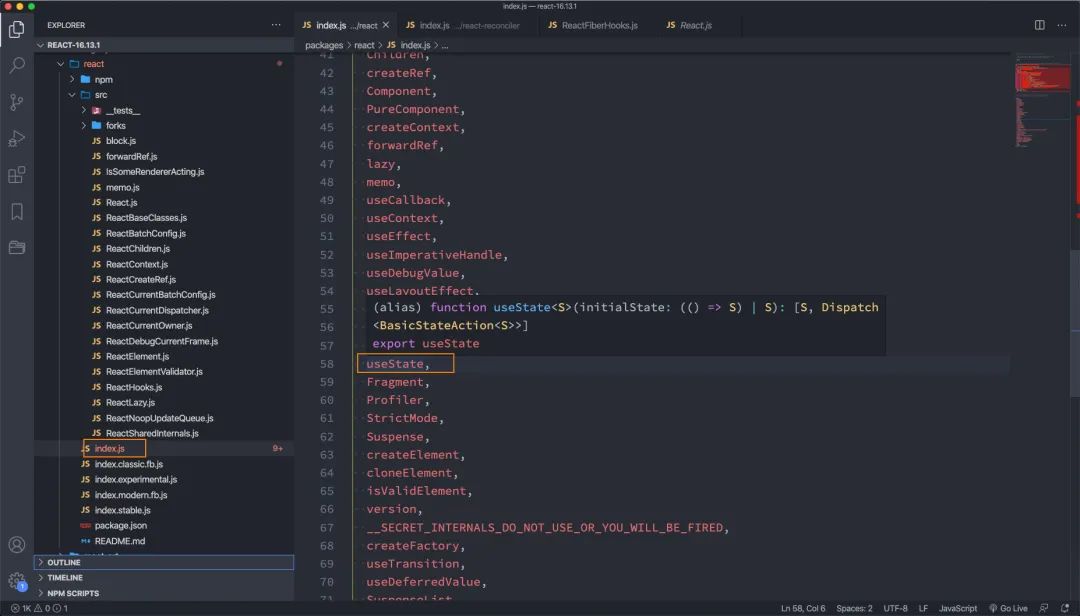
点到useState的源码中:
- useState本质上,是使用的dispatcher的useState;
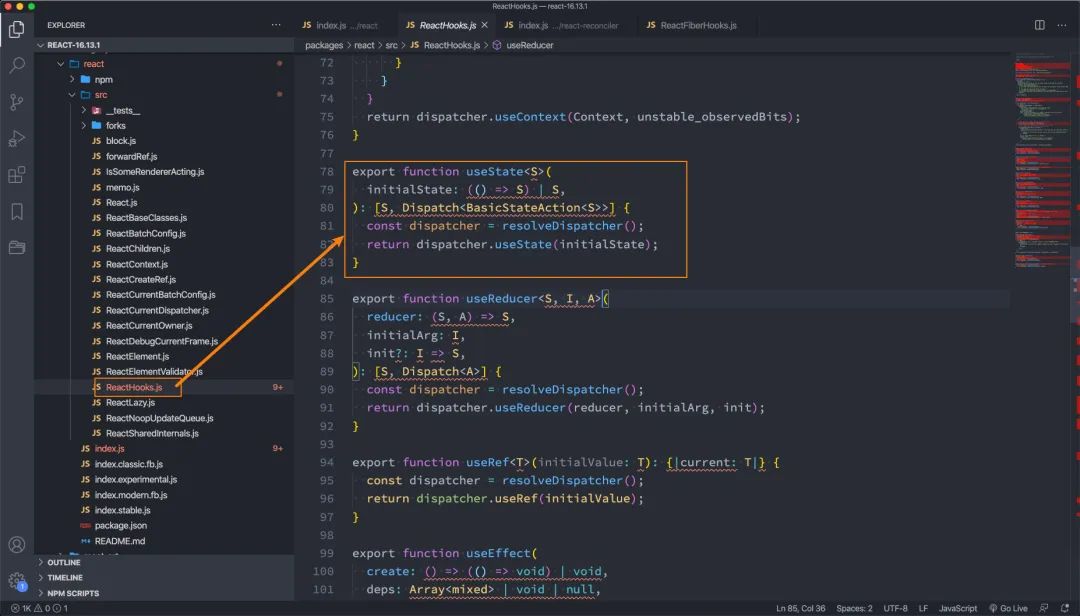
dispatcher来自另外的一个函数resolveDispatcher:
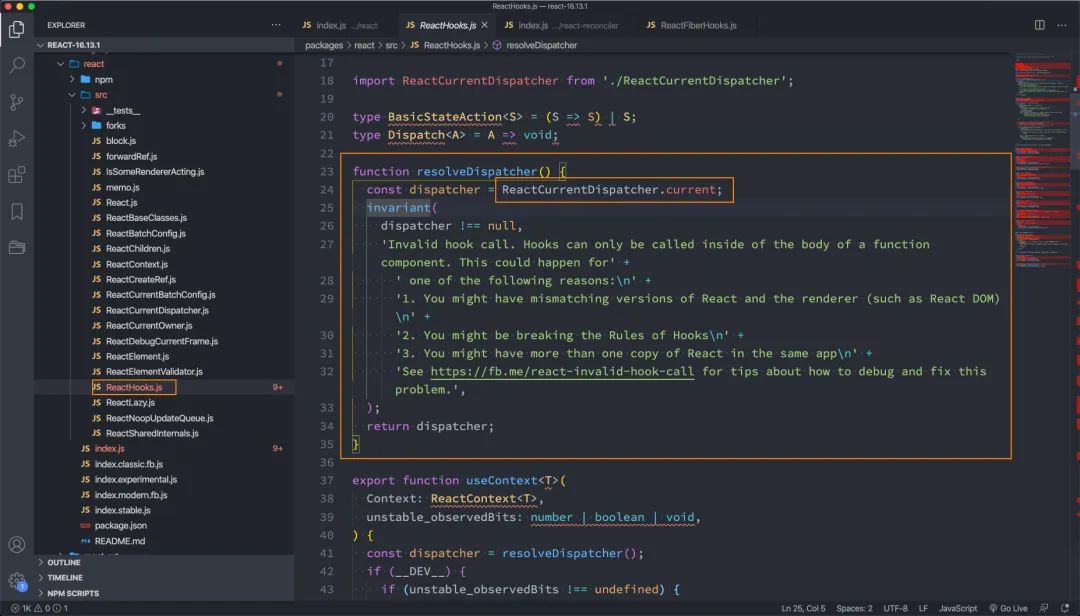
运行的过程中,会赋值一个current的值是一个Dispatcher类型:
- Dispatcher来自于
react-reconciler/src/ReactFiberHooks
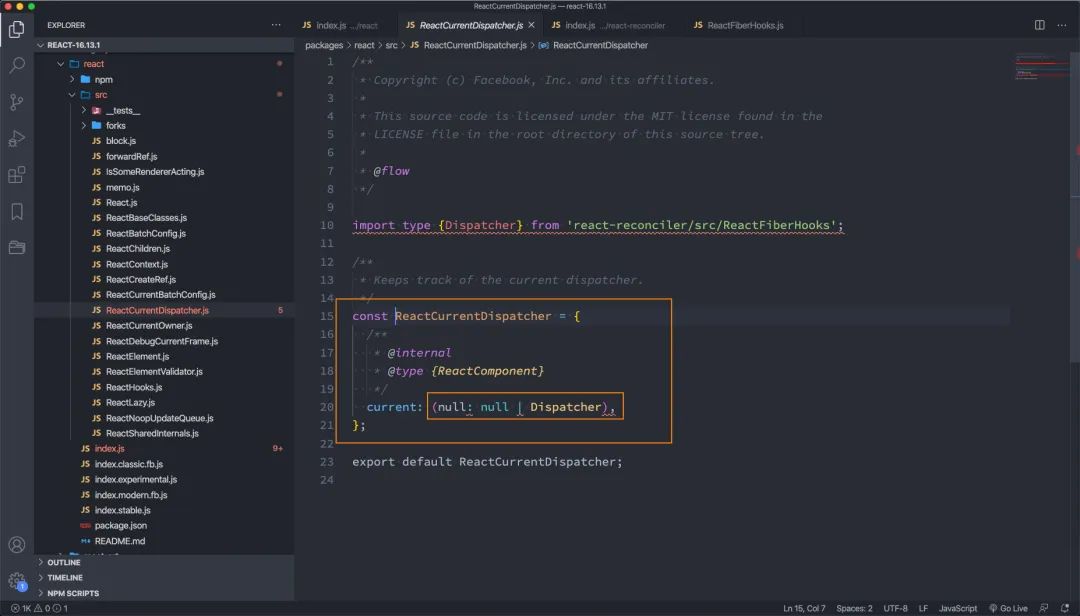
Dispatch类型的定义:
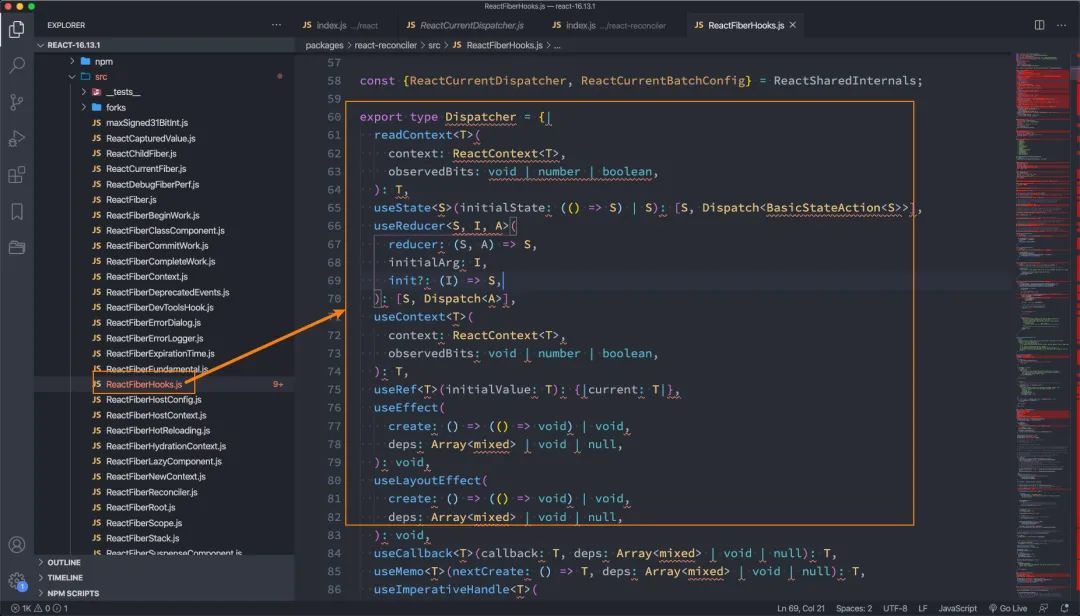
这里的Dispatch仅仅是一个类型而已,我们赋值具体的值在不同的阶段是不同的:
- 在挂载阶段:HooksDispatcherOnMount
- 在更新阶段:HooksDispatcherOnUpdate
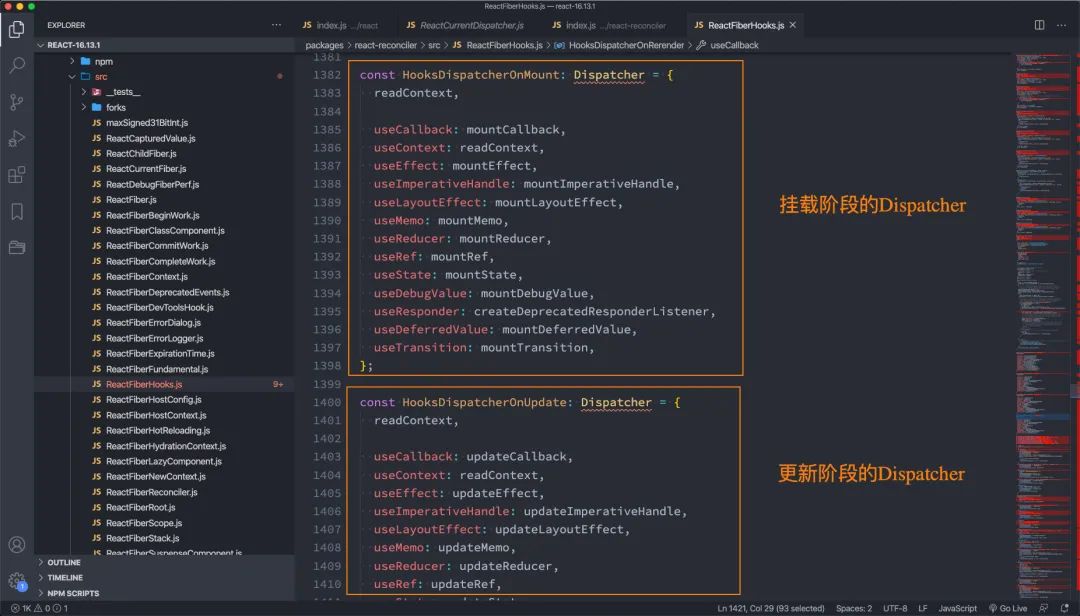
挂载哪一个取决于renderWithHook函数:

3.2. HooksDispatcherOnMount
HooksDispatcherOnMount对应的useState是mountState
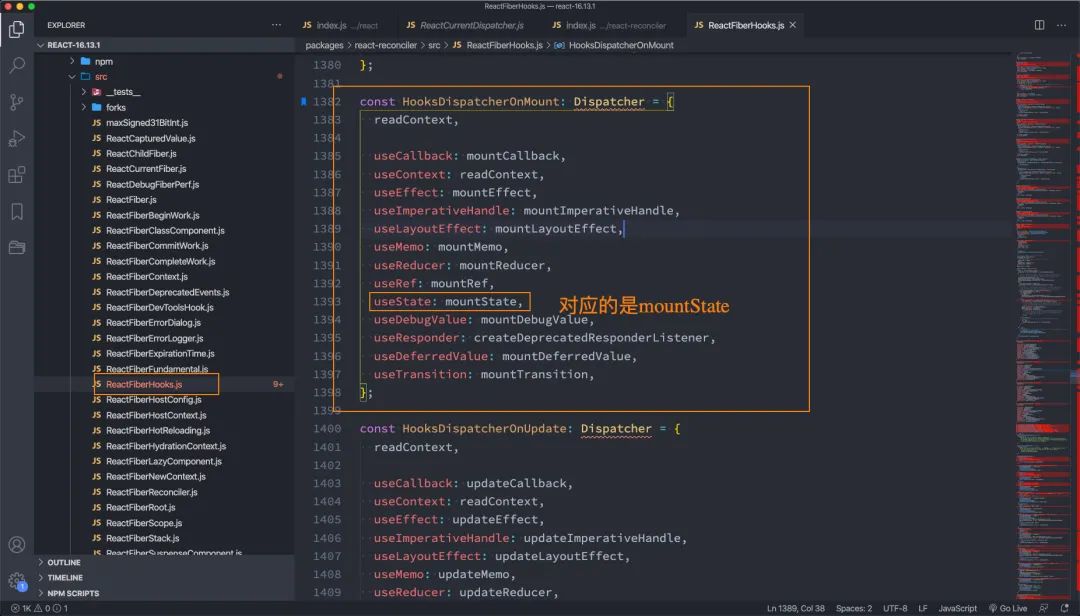
mountState的源码:
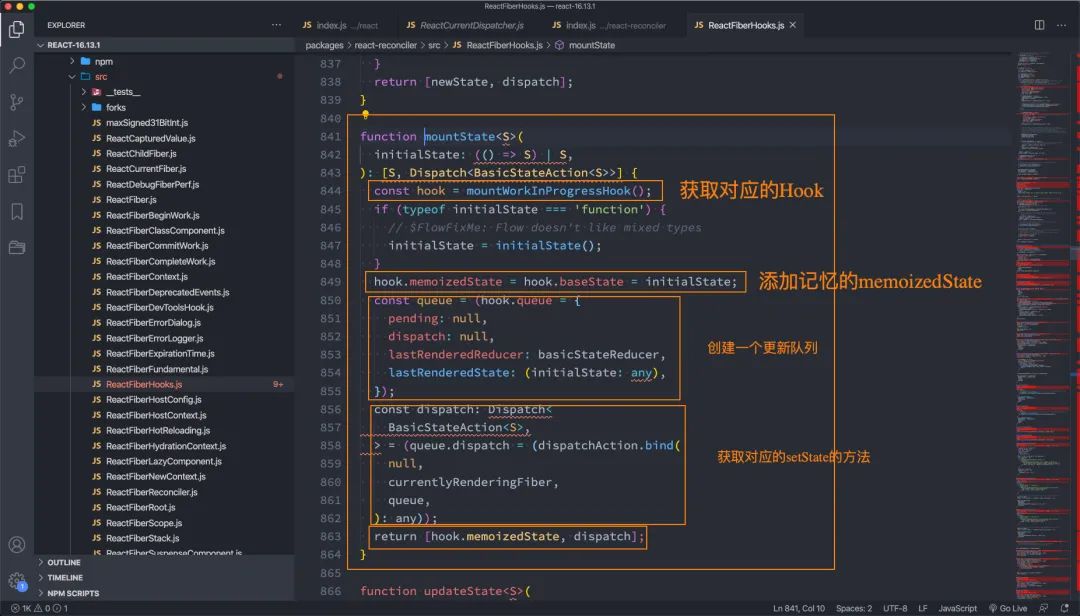
绑定的dispatchAction函数,事实上是将所有的action放到了queue的队列中:
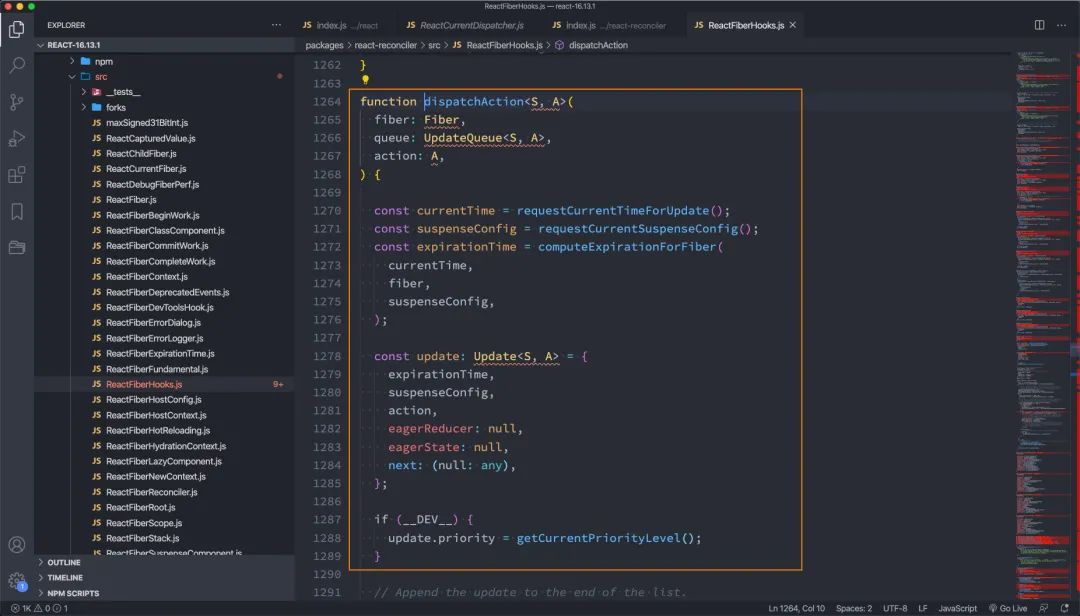
3.3. HooksDispatcherOnUpdate
HooksDispatcherOnUpdate对应的useState是updateState
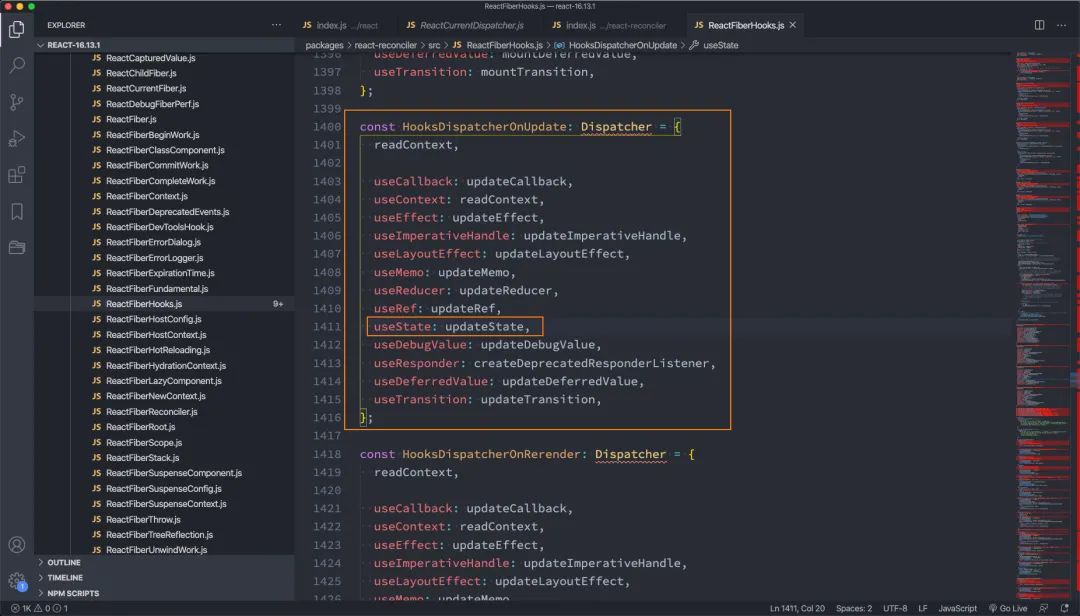
updateState本质上会执行updateReducer:
- 所有其实就更新阶段而言,useState本质上用的是updateReducer

updateReducer的源码如下:
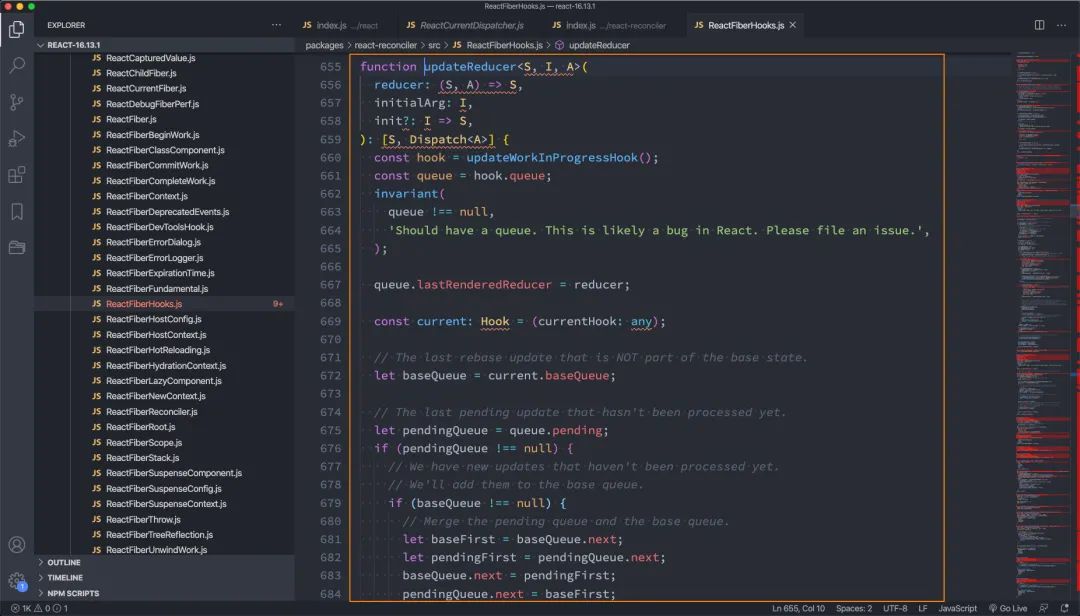
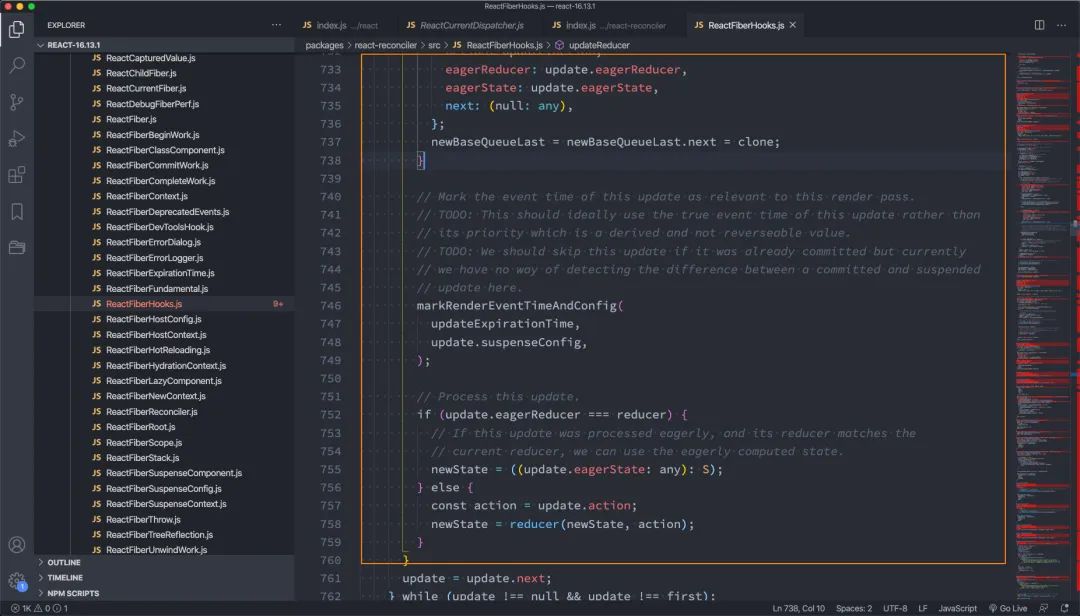
四. Redux Hooks
在之前的redux开发中,为了让组件和redux结合起来,我们使用了react-redux中的connect:
- 但是这种方式必须使用
高阶函数结合返回的高阶组件; - 并且必须编写:
mapStateToProps和mapDispatchToProps映射的函数;
在Redux7.1开始,提供了Hook的方式,我们再也不需要编写connect以及对应的映射函数了
4.1. useSelector使用
useSelector的作用是将state映射到组件中:
- 参数一:将state映射到需要的数据中;
- 参数二:可以进行比较来决定是否组件重新渲染;(后续讲解)
const result: any = useSelector(selector: Function, equalityFn?: Function)
现在,我可以改进一下之前的Profile中使用redux的代码:
function Profile(props) {
const {banners, recommends, counter} = useSelector(state => ({
banners: state.homeInfo.banners,
recommends: state.homeInfo.recommends
}));
console.log("Profile重新渲染");
return (
<div>
<h2>数字: {counter}</h2>
<h1>Banners</h1>
<ul>
{
banners.map((item, index) => {
return <li key={item.acm}>{item.title}</li>
})
}
</ul>
<h1>Recommends</h1>
<ul>
{
recommends.map((item, index) => {
return <li key={item.acm}>{item.title}</li>
})
}
</ul>
</div>
)
}但是这段代码会有一个问题:
- 当前我们的组件并不依赖counter,但是counter发生改变时,依然会引起Profile的重新渲染;
原因是什么呢?
- useSelector默认会比较我们返回的两个对象是否相等;
- 如何比较呢?
const refEquality = (a, b) => a === b; - 也就是我们必须返回两个完全相等的对象才可以不引起重新渲染;
这个时候,我们可以使用react-redux中给我们提供的 shallowEqual:
- 这段代码的作用是避免不必要的重新渲染;
const {banners, recommends, counter} = useSelector(state => ({
banners: state.homeInfo.banners,
recommends: state.homeInfo.recommends
}), shallowEqual);当然,你也可以编写自己的比较函数,来决定是否重新渲染。
4.2. useDispatch
useDispatch非常简单,就是直接获取dispatch函数,之后在组件中直接使用即可:
const dispatch = useDispatch()
直接使用dispatch:
<button onClick={e => dispatch(subAction(1))}>-1</button>
<button onClick={e => dispatch(subAction(5))}>-5</button>我们还可以通过useStore来获取当前的store对象:
const store = useStore()
在组件中可以使用store:
const store = useStore();
console.log(store.getState());